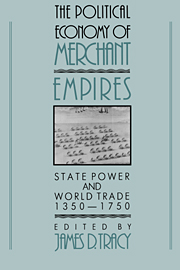Book contents
- Frontmatter
- Contents
- Acknowledgments
- Introduction
- 1 Institutions, Transaction Costs, and the Rise of Merchant Empires
- 2 Merchants and States
- 3 The Rise of Merchant Empires, 1400–1700: A European Counterpoint
- 4 Europe and the Wider World, 1500–1700: The Military Balance
- 5 The Pirate and the Emperor: Power and the Law on the Seas, 1450–1850
- 6 Transport Costs and Long-Range Trade, 1300–1800: Was There a European “Transport Revolution” in the Early Modern Era?
- 7 Transaction Costs: A Note on Merchant Credit and the Organization of Private Trade
- 8 Evolution of Empire: The Portuguese in the Indian Ocean During the Sixteenth Century
- 9 Comparing the Tokagawa Shogunate with Hapsburg Spain: Two Silver-Based Empires in a Global Setting
- 10 Colonies as Mercantile Investments: The Luso-Brazilian Empire, 1500–1808
- 11 Reflections on the Organizing Principle of Premodern Trade
- Selected Bibliography of Secondary Works
- Index
4 - Europe and the Wider World, 1500–1700: The Military Balance
Published online by Cambridge University Press: 25 March 2010
- Frontmatter
- Contents
- Acknowledgments
- Introduction
- 1 Institutions, Transaction Costs, and the Rise of Merchant Empires
- 2 Merchants and States
- 3 The Rise of Merchant Empires, 1400–1700: A European Counterpoint
- 4 Europe and the Wider World, 1500–1700: The Military Balance
- 5 The Pirate and the Emperor: Power and the Law on the Seas, 1450–1850
- 6 Transport Costs and Long-Range Trade, 1300–1800: Was There a European “Transport Revolution” in the Early Modern Era?
- 7 Transaction Costs: A Note on Merchant Credit and the Organization of Private Trade
- 8 Evolution of Empire: The Portuguese in the Indian Ocean During the Sixteenth Century
- 9 Comparing the Tokagawa Shogunate with Hapsburg Spain: Two Silver-Based Empires in a Global Setting
- 10 Colonies as Mercantile Investments: The Luso-Brazilian Empire, 1500–1808
- 11 Reflections on the Organizing Principle of Premodern Trade
- Selected Bibliography of Secondary Works
- Index
Summary
In the Victoria and Albert Museum in London, there is an ivory chess set, made for Tippu Sultan of Mysore during the late eighteenth century. One set of chessmen represents an Indian princely army, whose soldiers wield swords and hold shields; their adversaries, however, are the European officers and native infantry of the British East India Company – all in uniform, and all impressively equipped with firearms. This contrast neatly symbolizes a central feature of European overseas expansion since the Middle Ages: namely, the absolute or relative superiority of Western weaponry and Western military organization over all others. Amid the wealth of statistics on Europe's import of Asian spices, on the silver production of colonial America, or on the export of African slaves, it is easy to forget that each of these lucrative economic enterprises rested in the last analysis upon force. Although other chapters in this volume stress lower transaction costs as a key explanation of Europe's commercial expansion, it was often a minor consideration overseas, where even the sharpest and most sophisticated business methods would scarcely have been competitive without the sanction of superior force on the part of the Western merchants. As Irfan Habib put it in his perceptive contribution to The Rise of Merchant Empires:
‘Could it be that the European triumph over Indian (and Asian) merchants was not, then, one of size and techniques, of companies over peddlars, of joint-stock over atomized capital, of seamen over landsmen? Might it not have been more a matter of men-of-war and gun and shot?’
- Type
- Chapter
- Information
- The Political Economy of Merchant EmpiresState Power and World Trade, 1350–1750, pp. 161 - 195Publisher: Cambridge University PressPrint publication year: 1991
- 6
- Cited by



